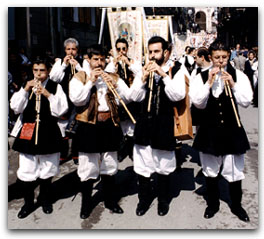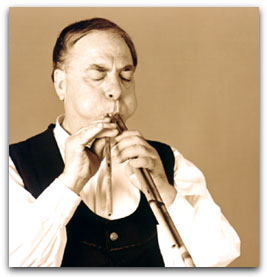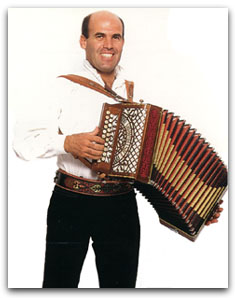Talking about MUSICAL
INSTRUMENTS the "launeddas" deserve a privileged place as they are the most typical
sonorous instrument in Sardinia. The Egyptian "argul" is probable the only instrument
similar to the "launeddas". Its predecessor, the "benas" is a flute made of fen cane with
a "trumbitta" (small trumpet) that fits in a resonating pipe with three holes. Three
fen canes constitute the "launeddas": the "tumbu", which is the longest and is
tied to "sa mancosa manna" with a string, and the "mancosedda" or "destrina" on which the melody
is played. It takes long years of study and application to master the difficult technique needed to play
this instrument.
|
|

 Launeddas players Launeddas players |

 Luigi Lai from San Vito Luigi Lai from San Vito |
|
Its remote origins can be seen in the
so called Ithyphallic small bronze which dates back to the eighth century BC. It was
discovered in the countryside near Ittiri and depicts a launeddas player.
The tradition of this instrument, preserved by undisputed contemporary virtuosos
such as Luigi Lai from San Vito and Aurelio Porcu from Villaputzu, is also secured
by cultural societies and schools in Quartu and in the Sarrabus which are attended
by young students.
In the last few years there has been a new interest in the "launeddas", which has led
to them being used in non-traditional music such as jazz and rock.
|
In the past the "launeddas" were
widely used to accompany the dances in the squares until they were replaced by the
two rows
melodeon (a kind of accordion) invented by the Viennese Damian in 1829. The melodeon was
brought to Italy by Paolo Soprani in 1863 and soon became integrated into the island's musical tradition.
Nowadays Totore Chessa from Irgoli is one of the greatest performers on the island. In this survey of
Sardinian instruments we must mention the "serraggia" which is made from a cane pipe, a swollen and
dried pig bladder and a stretched string which is rubbed with a lentisk bow; "su pipiolu" that is the
sheperd's pipe made from fen cane; among the percussion instruments there are the drums "tumbarinu"
from Aidomaggiore and Gavoi.
|
|

 Totore Chessa from Irgoli Totore Chessa from Irgoli |
An exhaustive study of Sardinian
instruments can be carried out in Tadasuni, a very small village in the area of Oristano, where
don Giovanni Dore has founded an extraordinary and unique museum.
Some of these instruments (particularly the "launeddas") as well as many stylistic features of the
Sardinian musical tradition are being used nowadays in new musical contexts. In the wake of the
growing interest in ethnic music we have seen a growing respect for and a modern development
of this heritage. This has led to and interesting mix of traditional and non-traditional styles and
instruments.
|
|